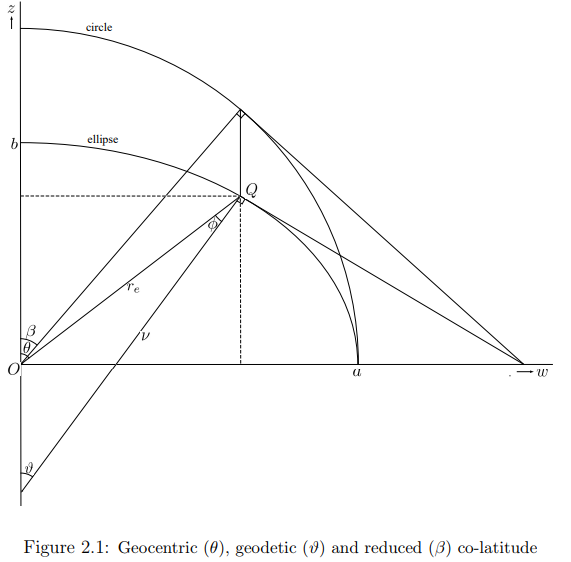Claessens, S.J. 2006
- p. 16
[math]tan θ = \frac{a}{b} tan β =\frac{a^2}{b^2} tan ϑ[/math] , где
- [math]\theta[/math] - co-latitude, geocentric,
- [math]\vartheta[/math] - co-latitude, geodetic,
- [math]\beta[/math] - co-latitude, reduced
- p. 17
Прямоугольная система координат#Z вверх, где
- [math]\nu[/math] - Радиус Земли, поперечный
- [math]Q^\prime[/math] - Датум, точка на поверхности
- p. 20
[math]\phi = \theta - \vartheta[/math], где [math]\phi[/math] - deflection angle, ellipsoidal
from spherical to ellipsoidal harmonics[править]
- p. ii
Numerical closed-loop simulations have shown that the accuracy of geopotential coefficients obtained with the new methods is significantly higher than the accuracy of existing methods that use the spherical harmonic framework.
- p. 2
The error resulting from a spherical approximation is often assumed to be of the order of the flattening of the Earth (∼ 0.3%), but may be even larger due to the combined effect of subsequent approximations (e.g., Sans`o and Tscherning, 2003; Tscherning, 2004). For a geoid-ellipsoid separation of 100 m, the error induced by a spherical approximation is therefore in the order of 30 cm and possibly larger... aim to compute a geoid model accurate to 1 cm (Rapp, 1997a). Naturally, highly accurate modelling of the geoid and the Earth’s external gravity field is only possible if the required rigorous theoretical methodologies exist. This calls for a solution of a BVP where the boundary is formed by an ellipsoid of revolution, i.e., an ellipsoidal BVP.
- p. 12
The ideal is to obtain a practical solution in the spherical harmonic framework that can match or even supersede the accuracy of the methods based on ellipsoidal harmonics.
